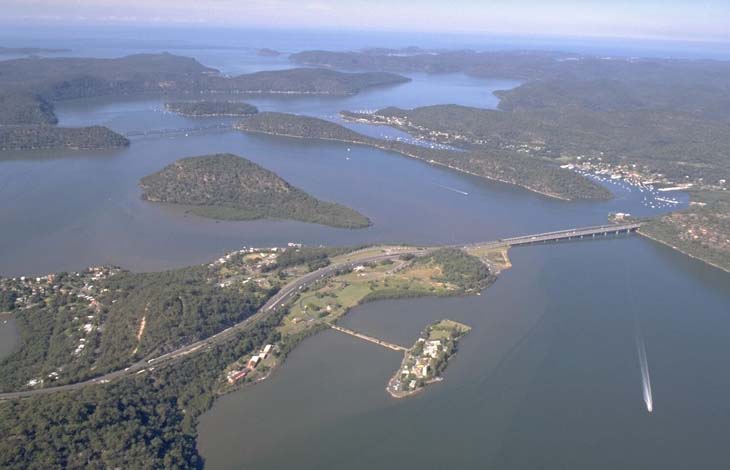The Hawkesbury River estuary marks the northern boundary of the Greater Sydney Metropolitan region and the southern boundary of the Central Coast region of New South Wales. The estuary is a large drowned valley that drains the second largest coastal catchment in the state and enters the ocean via Broken Bay and Pittwater.
The significance of the Hawkesbury River cannot be understated. The catchment supports large agricultural and tourism industries, to name just two. Many of its major tributaries are regulated and provide drinking water for millions of people. It hosts myriad recreational activities for residents of the local government areas it encompasses as well as visitors to the Greater Sydney region. It has a rich colonial history, and a significant traditional history.
The Hawkesbury–Nepean River and its tributaries are a defining feature of Greater Sydney.
Water quality report card
As part of our water quality monitoring program we assess the water quality and ecosystem health of an estuary using a range of relevant indicators. We sample a subset of the estuaries located between Taree and Wollongong every 3 years. The most recent sampling in the Hawkesbury River was completed over the 2019–20 summer at 2 sites.
This report card represents 2 water quality indicators that we routinely measure: the amount of algae present and water clarity. Low levels of these 2 indicators equate with good water quality.
The report card shows the condition of the estuary was fair with:
- algae abundance graded fair (C)
- water clarity graded good (B)
- overall estuary health graded fair (C).
Grades for algae, water clarity and overall are represented as:
- A – excellent
- B – good
- C – fair
- D – poor
- E – very poor.
Go to estuary report cards to find out what each grade means, read our sampling, data analysis and reporting protocols, and find out how we calculate these grades.
We also sample a number of inflowing tributaries of the lower Hawkesbury River, including Mooney Mooney Creek, Patonga Creek and Mullet Creek as part of a collaborative program with Central Coast Council. The most recent sampling was completed over the 2019–2020 summer.
The results of the monitoring program, including a detailed water quality report card for the inflowing tributaries, are available on the Central Coast Council website.
We have monitored water quality in the Hawkesbury River since 2010. This table shows the water quality grades for this estuary over that time.
| Year | Algae | Water clarity | Overall grade |
|---|---|---|---|
| 2010–11 | C | E | D |
| 2013–14 | D | C | C |
| 2016–17 | C | D | C |
Physical characteristics
| Estuary type | Drowned river valley |
|---|---|
| Latitude | –33.56 (ºS) |
| Longitude | 151.31 (ºE) |
| Catchment area | 21,624.1 km2 |
| Estuary area | 114.5 km2 |
| Estuary volume | 1,541,412 ML |
| Average depth | 13.8 m |
Tidal exchange volume
Tidal exchange volume or tidal prism data is available for this estuary. This tidal prism was measured in 1993.
| Tide state | Flow (ML) | Local tidal range (m) | Sydney Harbour tidal range (m) |
|---|---|---|---|
| Ebb flow | 191,000 | 1.6 | 1.53 |
| Flood flow | 199,000 | 1.66 | 1.63 |
Notes: km2 = square kilometres; m = metres; m3 = cubic metres; ML = megalitres.
Water depth and survey data
Bathymetric and coastal topography data for this estuary are available in our data portal.
Land use
Over 70% of the Hawkesbury River catchment remains as undisturbed forest, a lot of which is protected within conservation areas. Grazing areas account for around a quarter of land-use, with urban areas and mixed horticulture making up the remainder of the catchment.
Water use
Find out about water use in the Hawkesbury River, including information about major water users, real-time flow data, and environmental and water sharing plans.
National and marine parks
- Wollemi National Park and the Blue Mountains National Park are the largest conservation areas in this catchment.
- This estuary does not flow into a marine park.
Community involvement
A host of landcare groups operate within the Hawkesbury catchment, through which volunteers can get involved in environmental work. For example, Hornsby Shire Council coordinates a bushcare group.
Seafood harvest area status
The NSW Food Authority website lists the current status of oyster/shellfish harvest areas.
Local government management
Local councils manage estuaries within their area unless the estuary is attached to a marine park. The Hawkesbury and Nepean Rivers flow through a number of local government areas.
Hornsby Shire Council manages the Hawkesbury estuary. Information about this estuary can be found on the council’s Hawkesbury estuary webpage.
Threatened species
The sandstone bush rock around the Hawkesbury River provides critical habitat for the endangered broad-headed snake.
Find out more about the biodiversity in our estuaries.
